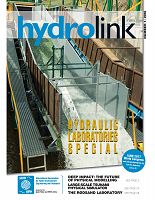IML-CZO researchers featured in ‘Hydrolink’ magazine
Three IML-CZO researchers recently co-authored an article in Hydrolink magazine which examined the Hydraulics and Sedimentation Laboratory (HSL) at the University of Tennessee in Knoxville.
IML-CZO Co-Director Thanos Papanicolaou, Investigator Chris Wilson, and graduate student researcher Benjamin Abban as well as HSL manager Achilleas Tsakiris collaborated on the article which looked at the state-of-the-art laboratory dedicated to environmental fluid mechanics, sedimentation engineering, and watershed science. Similar to how the IML-CZO studies issues at both the local and global level, the HSL “aims to provide knowledge and address hydraulic engineering problems, while promoting at the same time the adoption of adaptive strategies towards addressing contemporary and future challenges at the state, regional, national and international levels.”
The HSL provides opportunities for research that will contribute to the IML-CZO project. Research at the HSL is divided into three categories: (1) Coarse-grained stream hydraulics, stream restoration, sediment transport processes; (2) Cohesive soil/sediment transport dynamics and source tracing; and (3) Ecological and biogeochemical processes in watershed and estuarine environments.
“The main thrust of the research activity at HSL is focused on the study of fundamental environmental fluid mechanics, hydraulics and sediment transport mechanics in coarse grained streams,” the authors write. Researchers study the ways in which large boulders and similar structures affect flows and sediment transportation in waterways which can then affect fish habitat and water quality. Researches study these issues using two 10-meter long, 0.60 meter wide, water-recirculating flumes with an adjustable slope of up to 5 percent. One of the flumes also allows sediment recirculation. The lab also offers an array of measurement devices including a Hi-Speed Particle Image Velocimetry (PIV) system, a 2D Laser Doppler Velocimeter (LDV) system, several 3D Acoustic Doppler Velocimeters (ADV), geophones, micro-pressure transducers, Radio Frequency IDentification (RFID) sediment particle tracking equipment, sonar bathymetric devices, and more.
Another major research focus of the HSL looks at the erosion of cohesive stream banks. Through this research, scientists and engineers hope to better understand lateral stream migration, the structural integrity of bridges, highways, and other infrastructure, water quality, and loss of arable land. By isolating different mechanisms of bank erosions and factoring in certain soil properties, the researchers aim to help engineers and planners to reduce erosion along waterways. Once again, a wide of array of measurement techniques are used in these studies including miniature pressure transducers, high-definition imaging and image analysis, and a microscope lens assist to make detailed measurements of pore water pressure and observations of the soil structure.
The third research focus of the HSL examines the source and transportation of sediment and nutrients. This is particularly relevant to the IML region where nutrients such as nitrogen and phosphorus from farm runoff has created water issues not only in the Midwest but has also contributed to the hypoxic “dead zone” in the Gulf of Mexico. To study these issues, researchers use a mobile rainfall simulator to better understand soil transportation, erosion, infiltration, and other factors during rain events to help farmers, land managers, and other stakeholders better manage their land.
The HSL has created an opportunity for collaborative research with other laboratories in Australia, New Zealand, India, and Europe. Additionally, the lab has opened up research opportunities with several U.S. governmental agencies including the Bureau of Reclamation, Department of Agriculture, Army Corps of Engineers, and U.S. Geological Survey. The lab is also working with the Tennessee Valley Authority and the University of Virginia to study issues specific to the region.
Dr. Papanicolaou – a professor of civil and environmental engineering at the University of Tennessee-Knoxville – stressed that the lab aims to study issues relating to “current real-world needs” as opposed to hypothetical scenarios.
“HSL with the help of several individuals within the department of CEE [Civil and Environmental Engineering], COE [College of Engineering] and beyond has risen to a level of excellence,” Dr. Papanicolaou said in a press release. “The lab is suited to address statewide problems related to water resources engineering, agricultural engineering, and issues of national importance such as the hypoxia in the Gulf of Mexico, nutrient dynamics and infrastructure issues.”
Grant funding for HSL projects has come from NASA, the Tennessee Valley Authority, and the U.S. Departments of Energy, Transportation, Agriculture, and Defense.
Hydrolink is the primary magazine for the International Association for Hydro-Environmental Engineering and Research.
By Nick Fetty (Journalism, University of Iowa)
News Source:
READ MORE from Hydrolink >>
News Category:
PUBLICATIONS |
PEOPLE
Photos
IML-CZO Research: Breaking New Ground

Straightened or dredged streams are a common sight in the Upper Midwest.

The loess-derived soils in the IML-CZO are highly productive due to their strong soil structure and nutrient availability, but are also relatively homogeneous and highly erodible.

Clear Creek Site Manager Chris Wilson and a grad student, Ben Abban, study a soil sample.
The IML-CZO focuses on the Midwest, which is one of the most intensively managed landscapes in the world.
People Involved
CZO
-
IML, INVESTIGATOR
-
IML, INVESTIGATOR
-
IML, GRAD STUDENT
-
IML, GRAD STUDENT
Explore Further





